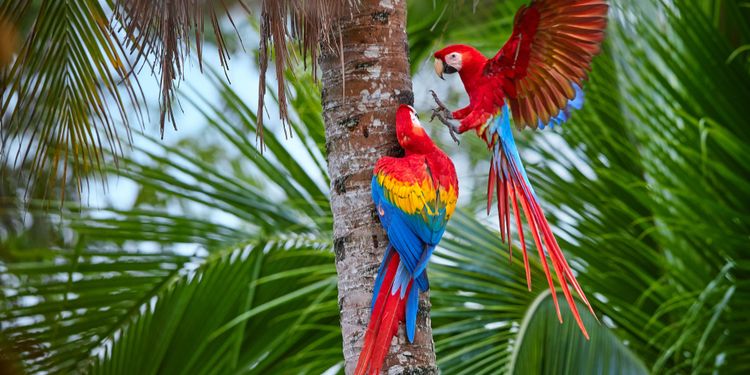
If you're passionate about adventure travel, staying in your host country can be a unique opportunity to explore its land and marine biodiversity as well as that of neighbouring countries. During your free time or in the weekend, why not take a few days to hike in the forests or mountains, take a stroll in a national park, or plan a safari? For wildlife lovers, Expat.com has compiled a short list of best destinations around the world to observe fauna.
USA

If we say the USA, big cities like New York, Los Angeles and San Francisco are probably the things that will first come to your mind. However, given the size of its territory, the USA has vast land and marine biodiversity that perhaps goes beyond your imagination. While you may be tempted to visit urban parks, aquariums and zoos, there's much more to the country's natural heritage. The USA has many forests and natural reserves sheltering a wide range of animal species in different environments and climates. Today, you can find more than 8,276 species, including 38 mammals, 56 amphibians, 91 birds, 40 reptiles and 274 fish. Also, 395 of them are classified as critically endangered species. Hammerhead sharks, sea otters, and Hawaiian monk seals are among the 391 species which are in danger of extinction. If you're not scared freezing temperatures, take a trip to Alaska where mountains and gigantic glaciers are the shelters of bears, grizzlies and thousands of bird species. In Louisiana, you will come across alligators, wild boars and racoons. California is famous for its condors and sea lions. The bobcat is a species that adapts to all types of environments, including urban and suburban areas.
Venezuela

Stretching over 916,445 km², Venezuela can boast of a tropical climate, varied landscapes and its immense natural wealth that you can explore during your free time, whether you've moved there or to another country in South America. Venezuela's beautiful fauna is made up of about 50% amphibians and 23% reptiles. The vertebrate fauna comprises some 2,120 terrestrial species and 1,000 fish species. Among mammals, there are more than 300 terrestrial species and some twenty aquatic species. In the nature reserves and coastal regions, you can find some 1,300 endemic bird species. East of Caracas is the Parque Nacional Henri Pittier with more than 500 animal and bird species in a territory of 1,078 km². Los Llanos is the place to be if you've always dreamed of seeing an anaconda for real. Elsewhere, you can come across caimans, ocelots, howler monkeys and giant otters. Orinoco shelters the largest crocodiles of the Americas, as well as manatees and freshwater dolphins. Since Venezuela is interspersed with lined with mangroves and surrounded by dense forests, you can also encounter felines like the jaguar, the puma and the ocelot. Snakes like the boa and rodents like the lowland paca and agouti are also commonly found in nature reserves.
Brazil

Brazil is another top destination for wildlife travel with more than 600 mammal species, 1,600 bird species, 40 turtle species, 330 amphibian species, 1,500 fish species, 230 snake species and five alligator species. Exploring Brazil's wildlife can take months and even years. Today, there are more than 100,000 species of invertebrates in the country, including 70,000 insects. The Amazon rainforest is home to more than 500 species of mammals, including the cougar, the lion tamarin, the tapir, the opossum and the jaguar. If you've always been fascinated by the sloth or the marmoset, it is the place to be! If you're expecting an encounter with a marsupilami, think again! Unlike this imaginary animal, piranhas are very real and inhabit the rivers. Among the bird species, you have the flamingo, macaw, parrot, hocco, and the harpy eagle. Away from the forests, you will be amazed by the variety of the aquatic fauna of the Abrolhos archipelago and that of Porto Belo. These regions are known to be a haven for diving and snorkelling. You can perhaps get the chance to observe catfish in their natural habitat at least once in your whole life. It's also worth noting that the unofficial list of new species keeps on growing.
Thailand

The Kingdom of Thailand can boast not only of its cultural heritage but also of its rich biodiversity thanks to its varying climates and landscapes. Wildlife is abundant, whether you're in the North or the South of the country. Today, more than one thousand bird species, some of which are migratory species, are listed. Among the 300 mammal species, there are tigers, spotted leopards, wild cats, the Indian bison, Malayan bears, elephants and Asian black bears. Most of these species live in sanctuaries or national parks. Dugongs, or sea cows, are among Thailand's endemic species. For those who don't have ophiophobia, Thailand is also the place where you can observe the king cobra, the green viper, and the reticulated python (which can stretch to up to 15 meters long) which are among the 313 species of reptiles. In Kanchanaburi, you can observe wild tigers roaming free. At the mouth of the Bang Pakong River in Chachoengsao Province, you can see dolphins. Thailand's forests are also home to thousands of insect species like beetles, spiders and butterflies.
Tanzania

Wildlife lovers need no introduction to Tanzania. Located in East Africa, Tanzania is famous for its vast wild plains, including the famous Serengeti National Park that stretches over 14,663 km² and is home to over 4 million carnivorous and herbivorous species. The Kilimanjaro National Park is another must-see. If you're planning a safari in any of these parks, you will surely come across elephants, buffaloes, lions, leopards and rhinos, not to mention wildebeest and impala. It's worth noting that one-third of the Tanzanian territory is designated a protected area. Various wildlife species can also be seen in Tarangire, Ngorongoro, Manyara, Gombe and Mahale and Arusha national parks. Among the bird species, you have the pink flamingo who immigrates every year to the Serengeti Park, the malachite sunbird (souimanga), as well as the steppe eagle, the crown eagle, the cinnamon sparrow, the ostrich, the weaver, and the Kori bustard. An endangered species that you can still find in Tanzania's plains is the bat-eared fox. Zanzibar also has an impressive aquatic fauna with more than 350 fish species and 200 coral species. The island is a paradise for diving and snorkelling. Its terrestrial species include dozens of bird species, as well as blue and red colobuses who are endemic to Zanzibar.
Sources:



















